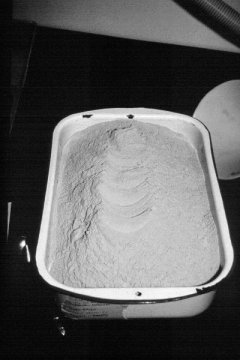Plant pollen should not be confused with bee pollen and its health food aspects. Tree, shrub, grass and weed pollens can be collected. They are used mainly for production of allergenic medicines and allergy testing. There are only a few processors of tree pollen in the United States and most are associated with large pharmaceutical companies. These companies collect pollen with their own staffs operating under the guidance of a professional botanist. They also purchase raw material (pollen) from a relatively small number of trained collectors located throughout the country. These pollen collectors harvest flowering structures from trees and shrubs on their own land as well as other private land owners. The pollen collectors pay private forest landowners a percentage of the value of flowers harvested, offering the fortunate landowner an opportunity for annual income.

During the collection season, collectors may work long hours and require specialized equipment. In most cases, tree pollen collection should be considered only as a supplemental income possibility. For this reason many pollen collectors are involved in other businesses such as tree service, forestry, medicinal plant collection, seed collection or farming.
Collectors partially dry the flowers prior to shipping to the processors. They are usually paid on a weight basis for their dried flowers. Rates are based upon the historic yield of pollen and the market value of the processed pollen. Prices vary for different species, but the species price is fairly constant from year to year. Collectors normally receive in the range of $5 to $40 per pound of dried flowers.
Once the pollen is cleaned and processed, it can be stored for several years. Thus, the processing companies will purchase large quantities of a species that exhibits an unusually large crop in a particular year. Processed pollen must meet exacting standards for purity and is sold to pharmaceutical companies who further refine it into liquid extracts.
Flowering structures are harvested by several different methods:
If you are interested in becoming a pollen collector, State forestry agencies and state Cooperative Extension services may have information about pollen collection activities in their respective states. (This paragraph edited on the web; October 10, 2003)
Below is a list of tree species from which pollen extracts are manufactured. This listing is
for general information only, may not be all-inclusive, and may contain species not
purchased by all processing companies.
Shelby G. Jones, consulting forester
Tree species from which pollen extracts are manufactured
| Common Name | Scientific Name(s)
| Acacia | Acacia spp.
| Alder | Alnus rhombifolia/rubra/velutina
| Ash | Fraxinus americana/pennsylvanica/velutina
| Aspen | Populus tremuloides
| Beech | Fagus grandifolia
| Beefwood | Casuarina equisetifolia
| Birch | Betula fontinalis/lenta/nigra
| Bottlebrush | Callistemon citrinus
| Boxelder | Acer negundo
| Cedar, Mtn. | Juniperus sabinoides
| Cedar, Red | Juniperus virginiana
| Cedar, Salt | Tamarix gallica
| Cottonwood | Populus trichocarpa/deltoides/fremonti
| Cypress, | Arizona Cupressus arizonica
| Elm | Ulmus americana/pumila
| Eucalyptus | Eucalyptus spp.
| Hackberry | Celtis occidentalis
| Hazelnut | Corylus americana
| Hickory/Pecan | Carya ovata/illinoensis/tomentosa
| Juniper | Juniperus californica/scopulorum/osteosperma/occidentalis
| Maple | Acer macrophyllum/rubrum/saccharum/saccharinum
| Melaleuca | Melaleuca leucadendron
| Mesquite | Prosopis juliflora
| Mulberry | Morus alba/rubra
| Oak | Quercus agrifolia/alba/dumosa/gambelii/rubra/velutina
| Olive, | European Olea europaea
| Palm, Date | Phoenix dactylifera
| Palo Verde | Cercidium torreyana
| Pecan | Carya pecan
| Pepper | Tree Schinus molle
| Pine | Pinus echinata/ponderosa/strobus
| Poplar | Poplar alba/deltoides/nigra
| Privet | Ligustrum vulgare
| Russian Olive | Elaeagnus angustifolia
| Sweetgum | Liquidambar styraciflua
| Sycamore | Platanus occidentalis/racemosa
| Tree of Heaven | Ailanthus altissima
| Walnut | Juglans californica/nigra/regia
| Willow | Salix discolor/lasiolepis/nigra
| | |